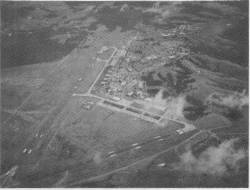- Author
- A.N. Other and NHSA Webmaster
- Subjects
- Naval Aviation
- Tags
-
- RAN Ships
- HMAS Albatross (Shore Establishment), HMAS Nabbington
- Publication
- September 1993 edition of the Naval Historical Review (all rights reserved)

The decision to build an airfield on the land now occupied by the Naval Air Station was taken soon after WWII was declared in 1939. The RAAF occupied the new base on 7 May 1942 and were soon followed by the US Army Air Corps and the Royal Netherlands East Indies Air Force.
In 1944 the British Admiralty directed certain Naval forces to the South West Pacific area, and this of course necessitated the provision of shore base establishments for the Royal Navy and its Fleet Air Arm in Australia.
RAAF Base Nowra was considered the ideal choice because of its proximity to Jervis Bay, which was large enough to accommodate the entire British Pacific Fleet. The Royal Navy’s Fleet Air Arm began operations at Nowra in late October 1944, and the base was renamed HMAS Nabbington. In March 1946, the base reverted to RAAF control `to be retained but not maintained’.
On 3 July 1947 the Commonwealth Defence Council approved the formation of a Fleet Air Arm which would be controlled and operated by the RAN. The initial planning provided for the purchase of two aircraft carriers, necessary aircraft and the establishment of shore facilities. The carriers were later named HMAS Sydney and HMAS Melbourne and the shore facilities were at Nowra.
HMAS Albatross was commissioned on 31 August 1948 and the 20th Carrier Air Group, comprising Sea Fury and Firefly aircraft, were brought from England to Australia by HMAS Sydney. These aircraft, operated by 805 and 816 Squadrons, disembarked to Nowra in May 1949. In November 1950 they were joined by the 21st Carrier Air Group of 808 and 817 Squadrons, also flying Sea Furies and Fireflies.
HMAS Albatross has been expanding ever since. As more capable aircraft have been acquired, so ground support facilities have had to be built to service the more sophisticated equipment. In April 1955, Sea Venoms and Gannets arrived and so radar workshops and test facilities were required. More aircraft in the skies necessitated stricter standards of air traffic control and a new control tower was built in 1958. Wessex helicopters with a dunking sonar capability required a further expansion in servicing techniques and skills in 1962.
In 1965 it was decided to buy American aircraft to replace the ageing British Gannets and Sea Venoms. Douglas Skyhawks and Grumman Trackers were the choice and additional avionics facilities were built to service the complex equipment these aircraft carried.
Albatross has recently taken delivery of the Seahawk helicopter which will restore to the RAN much of the capability lost when the Grumman Tracker squadrons were disbanded in 1983. Meanwhile, the modernisation processes continue. The wartime living accommodation has been replaced with modern brick buildings where both male and female sailors have individual cabins. The large galley produces food as fine as any restaurant, and the engine repair workshops rival those of Qantas.
Throughout the 40 years of the Air Station’s existence, naval personnel and their families have been associated with the many and varied activities which take place in the local community. In 1972 the then Shire Council, on behalf of the citizens of the Nowra area, conferred on the base the right of Freedom of Entry. This is regularly exercised, normally during the celebrations of the Shoalhaven Spring Festival.
The Naval Air Station is also host to a number of lodger units.
Details of these lodger units, the Australian Navy Reserve, the RAN Historic Flight, the Fleet Air Arm Squadrons, the Australian Naval Aviation Museum and the various departments of HMAS Albatross are included in this publication.




